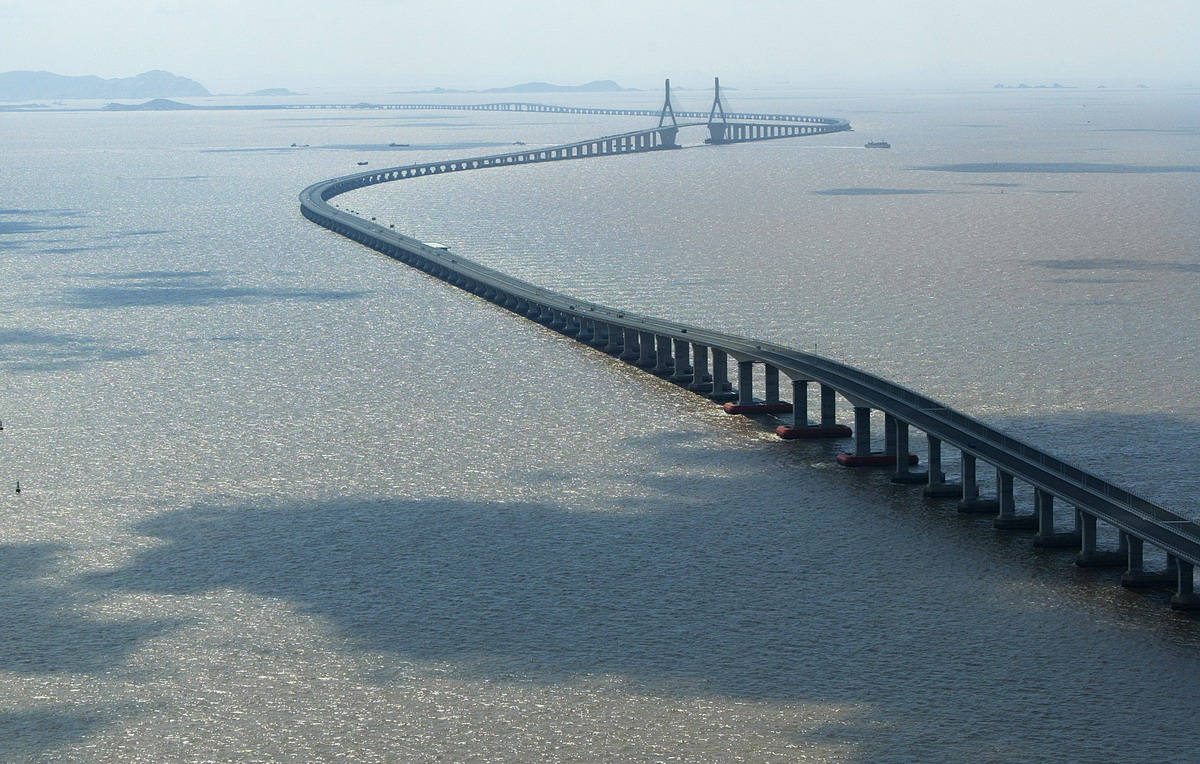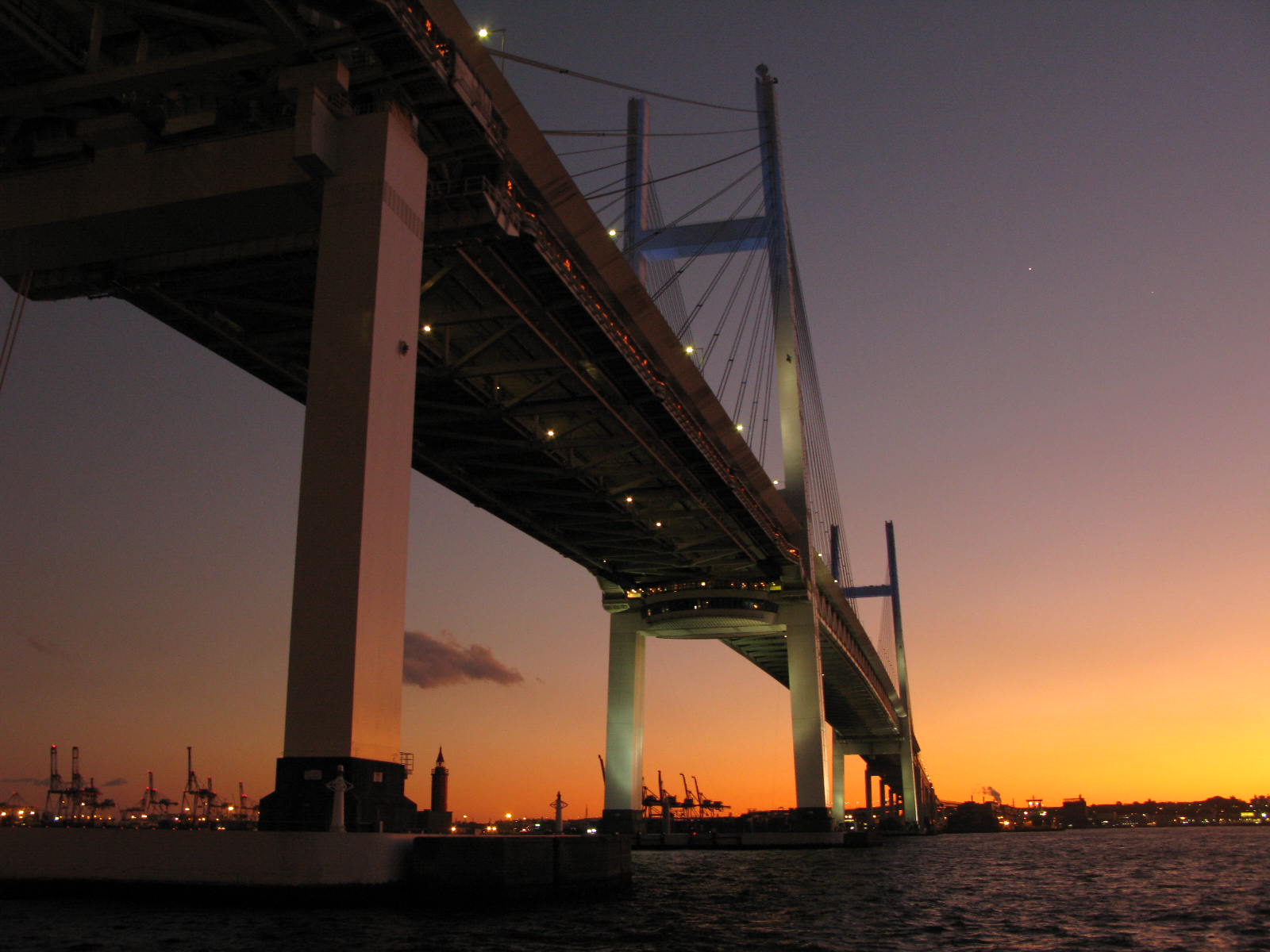|
Rainbow Bridge (Tokyo)
The is a suspension bridge crossing northern Tokyo Bay between Shibaura Pier and the Odaiba waterfront development in Minato, Tokyo, Japan. It is named ''Tōkyō Kō Renrakukyō'' (東京港連絡橋) as the official name in Japanese. It was built by Kawasaki Heavy Industries, with construction starting in 1987 and completed in 1993. The bridge is long with a main span of . Officially called the " Shuto Expressway No. 11 Daiba Route - Port of Tokyo Connector Bridge," the name "Rainbow Bridge" was decided by the public. The towers supporting the bridge are white in color, designed to harmonize with the skyline of central Tokyo seen from Odaiba. There are lamps placed on the wires supporting the bridge, which are illuminated into three different colors, red, white and green every night using solar energy obtained during the day. The bridge can be accessed by foot from Tamachi Station (JR East) or Shibaura-futō Station ( Yurikamome) on the mainland side. Usage The Rai ... [...More Info...] [...Related Items...] OR: [Wikipedia] [Google] [Baidu] |
Shuto Expressway
is a network of toll expressways in the Greater Tokyo Area of Japan. It is operated and maintained by the . Most routes are grade-separated (elevated roads or tunnels) and central routes have many sharp curves and multi-lane merges that require caution to drive safely. The speed limit is 60 km/h on most routes, but 80 km/h on the Bayshore Route, and 50 km/h on the Inner Circular Route. All trips on the expressway require a toll be paid. As of 2014, the cash toll for a standard-size car is Japanese yen, ¥1300 regardless of distance traveled. Vehicles using the Electronic toll collection, ETC toll-collection system pay a distance-based toll ranging from ¥300 to ¥1300 for ordinary vehicles (setoll price – in some cases substantially less than the previous fixed-rate toll. Lower cash rates exist for certain radial routes (where there are only a few kilometers of expressway remaining) and Electronic toll collection, ETC users have various time-of-day discounts. ... [...More Info...] [...Related Items...] OR: [Wikipedia] [Google] [Baidu] |
Shibaura-futō Station
is a station on the Yurikamome Line in Minato, Tokyo, Japan. It is numbered "U-05". Station layout The station consists of an elevated island platform An island platform (also center platform, centre platform) is a station layout arrangement where a single platform is positioned between two tracks within a railway station, tram stop or transitway interchange. Island platforms are popular .... It is located below a highway. Platforms History Shibaura-futō Station opened on 1 November 1995. References External links Official information site {{DEFAULTSORT:Shibaura-futo Station Railway stations in Tokyo Yurikamome Railway stations in Japan opened in 1995 ... [...More Info...] [...Related Items...] OR: [Wikipedia] [Google] [Baidu] |
Railway Bridges In Japan
Rail transport (also known as train transport) is a means of transport that transfers passengers and goods on wheeled vehicles running on rails, which are incorporated in tracks. In contrast to road transport, where the vehicles run on a prepared flat surface, rail vehicles (rolling stock) are directionally guided by the tracks on which they run. Tracks usually consist of steel rails, installed on sleepers (ties) set in ballast, on which the rolling stock, usually fitted with metal wheels, moves. Other variations are also possible, such as "slab track", in which the rails are fastened to a concrete foundation resting on a prepared subsurface. Rolling stock in a rail transport system generally encounters lower frictional resistance than rubber-tyred road vehicles, so passenger and freight cars (carriages and wagons) can be coupled into longer trains. The operation is carried out by a railway company, providing transport between train stations or freight customer facili ... [...More Info...] [...Related Items...] OR: [Wikipedia] [Google] [Baidu] |
Suspension Bridges In Japan
Suspension or suspended may refer to: Science and engineering * Suspension (topology), in mathematics * Suspension (dynamical systems), in mathematics * Suspension of a ring, in mathematics * Suspension (chemistry), small solid particles suspended in a liquid ** Colloidal suspension * Cell suspension or suspension culture, in biology * Suspension (mechanics), system allowing a machine to move smoothly with reduced shock * The superstructure of a suspension bridge * Suspensory behavior, arboreal locomotion of primates * Magnetic suspension, a method by which an object is suspended with no support other than magnetic fields * Car suspension Temporary revocation of privileges * Suspension (punishment), temporary exclusion as a punishment ** Suspension from the UK parliament ** Suspension (Catholic canonical penalty) * Suspension of driving privileges ("suspended driver's license") * Administrative License Suspension (ALS), US, driving license suspension without a court hearing ... [...More Info...] [...Related Items...] OR: [Wikipedia] [Google] [Baidu] |
Bridges In Tokyo
A bridge is a structure built to span a physical obstacle (such as a body of water, valley, road, or rail) without blocking the way underneath. It is constructed for the purpose of providing passage over the obstacle, which is usually something that is otherwise difficult or impossible to cross. There are many different designs of bridges, each serving a particular purpose and applicable to different situations. Designs of bridges vary depending on factors such as the function of the bridge, the nature of the terrain where the bridge is constructed and anchored, and the material used to make it, and the funds available to build it. The earliest bridges were likely made with fallen trees and stepping stones. The Neolithic people built boardwalk bridges across marshland. The Arkadiko Bridge (dating from the 13th century BC, in the Peloponnese) is one of the oldest arch bridges still in existence and use. Etymology The ''Oxford English Dictionary'' traces the origin of the wo ... [...More Info...] [...Related Items...] OR: [Wikipedia] [Google] [Baidu] |
List Of Longest Suspension Bridge Spans
The world's longest suspension bridges are listed according to the length of their main span (i.e. the length of suspended roadway between the bridge's towers). The length of main span is the most common method of comparing the sizes of suspension bridges, often correlating with the height of the towers and the engineering complexity involved in designing and constructing the bridge. If one bridge has a longer span than another it does not necessarily mean that the bridge is longer from shore to shore (or from abutment to abutment). Suspension bridges have the longest spans of any type of bridge. Cable-stayed bridges, the next longest design, are practical for spans up to just over 1 kilometre. Therefore, , the 31 longest bridges on this list are the 31 longest spans of all types of vehicular bridges (other than floating pontoon bridges). Currently, the 1915 Çanakkale Bridge in Turkey holds the record since opening to traffic in March 2022, with a span of . Since 1998, the A ... [...More Info...] [...Related Items...] OR: [Wikipedia] [Google] [Baidu] |
List Of Bridges
The list of bridges is a link page for any bridges that are notable enough to have an article, or that are likely to have an article in the future, sorted alphabetically by country. Lists of bridges by country Afghanistan Albania Algeria * Ouadi El Roukham Bridge Andorra Argentina *General Artigas Bridge *General Belgrano Bridge *Ingeniero Ballester Dam *Integration Bridge * Libertador General San Martín Bridge * Neuquén-Cipolletti bridges * Paso de los Libres – Uruguaiana International Bridge *Puente de la Mujer * Puente Transbordador * Puente Valentín Alsina *Rosario-Victoria Bridge *Salto Grande Bridge *San Roque González de Santa Cruz Bridge * Tancredo Neves Bridge *Zárate–Brazo Largo Bridge Armenia Aruba Australia * Albert Bridge, Brisbane *Alexandra Bridge, Rockhampton *Alfords Point Bridge, Sydney *Algebuckina Bridge, near Oodnadatta, South Australia *Andrew Nixon Bridge, St George *Anzac Bridge, Sydney *Batman Bridge, Launceston * Birkenhead Bri ... [...More Info...] [...Related Items...] OR: [Wikipedia] [Google] [Baidu] |
Yokohama Bay Bridge
The is an cable stayed bridge in Yokohama, Japan. Opened September 27, 1989, it crosses Tokyo Bay with a span of 460 metres (1,510 feet). The toll is ¥600. The bridge is part of the Bayshore Route of the Shuto Expressway is a network of toll expressways in the Greater Tokyo Area of Japan. It is operated and maintained by the . Most routes are grade-separated (elevated roads or tunnels) and central routes have many sharp curves and multi-lane merges that requi .... Notes External links * Naka-ku, Yokohama Bridges completed in 1989 Cable-stayed bridges in Japan Buildings and structures in Yokohama Toll bridges in Japan 1989 establishments in Japan Transport in Yokohama Double-decker bridges {{Kanagawa-geo-stub ... [...More Info...] [...Related Items...] OR: [Wikipedia] [Google] [Baidu] |
Tokyo Bay Aqua-Line
The , also known as the Trans-Tokyo Bay Expressway, is an expressway that is mainly made up of a bridge–tunnel combination across Tokyo Bay in Japan. It connects the city of Kawasaki in Kanagawa Prefecture with the city of Kisarazu in Chiba Prefecture, and forms part of National Route 409. With an overall length of 23.7 km, it includes a 4.4 km bridge and 9.6 km tunnel underneath the bay—the fourth-longest underwater tunnel in the world. Overview An artificial island, , marks the transition between the bridge and tunnel segments and provides a rest stop with restaurants, shops, and amusement facilities. A distinctive tower standing above the middle of the tunnel, the Kaze no Tō (の, "the tower of wind"), supplies air to the tunnel, its ventilation system powered by the bay's almost-constant winds. The ¥1.44 trillion (US$11.2 billion) roadway opened December 18, 1997, after 23 years of planning and nine years of construction. The Tokyo Bay Aqua- ... [...More Info...] [...Related Items...] OR: [Wikipedia] [Google] [Baidu] |
Akashi Kaikyo Bridge
The is a suspension bridge which links the city of Kobe on the Japanese island of Honshu to Iwaya on Awaji Island. It is part of the Kobe-Awaji-Naruto Expressway, and crosses the busy and turbulent Akashi Strait (''Akashi Kaikyō'' in Japanese). It was completed in 1998, and has the second longest central span of any suspension bridge in the world, at , only behind the 1915 Çanakkale Bridge that was opened in March 2022. It is one of the key links of the Honshū–Shikoku Bridge Project, which created three routes across the Inland Sea. History Background The Akashi Kaikyo Bridge forms part of the Kobe-Awaji-Naruto Expressway, the easternmost route of the bridge system linking the islands of Honshu and Shikoku. The bridge crosses the Akashi Strait (width 4 km) between Kobe on Honshu and Iwaya on Awaji Island; the other major part of the crossing is completed by the Ōnaruto Bridge, which links Awaji Island to Ōge Island across the Naruto Strait. Before the Akas ... [...More Info...] [...Related Items...] OR: [Wikipedia] [Google] [Baidu] |
Mount Fuji
, or Fugaku, located on the island of Honshū, is the highest mountain in Japan, with a summit elevation of . It is the second-highest volcano located on an island in Asia (after Mount Kerinci on the island of Sumatra), and seventh-highest peak of an island on Earth. Mount Fuji is an active stratovolcano that last erupted from 1707 to 1708. The mountain is located about southwest of Tokyo and is visible from there on clear days. Mount Fuji's exceptionally symmetrical cone, which is covered in snow for about five months of the year, is commonly used as a cultural icon of Japan and it is frequently depicted in art and photography, as well as visited by sightseers and climbers. Mount Fuji is one of Japan's along with Mount Tate and Mount Haku. It is a Special Place of Scenic Beauty and one of Japan's Historic Sites. [...More Info...] [...Related Items...] OR: [Wikipedia] [Google] [Baidu] |
.jpg)



.png)
.png)
